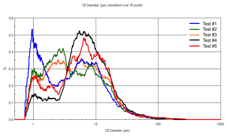

Particle engineering of cocrystals using a solvent-free approach by spray congealing
Iris Duarte1,2, Joao F. Pinto2, Marcio Temtem1*
1 Hovione Farmaciencia SA, Sete Casas, 2674-506 Loures, Portugal; *mtemtem@hovione.com or +351 219 847 569
2 iMed.ULisboa, Faculdade de Farmacia da Universidade de Lisboa, Av. Prof. Gama Pinto, 1649-003, Lisboa, Portugal
Around 90% of the new chemical entities emerging from the drug discovery phase present, at least, solubility constraints (BCS Class II+IV). Among the different solubilization strategies that have been applied to address this issue, the use of pharmaceutical cocrystals emerged as an alternative crystal-engineering platform to enhance the poor physicochemical properties of these challenging molecules [1].
Pharmaceutical cocrystals are stable multicomponent crystals, typically comprising two molecules, e.g. an API, or the salt of an API, and a coformer. The coformer can be an active or non-active ingredient (e.g. pharmaceutical excipients, vitamins, minerals, amino acids, other APIs) that has a favorable intermolecular interaction with the API, promoting hydrogen bonding, van der Wall forces or pi-stacking [2].
In general, and despite the great potential of cocrystallization, producing cocrystals with high efficiency at industrial scales is challenging due to the tight thermodynamic and kinetic crystallization windows necessary to achieve the desired crystalline form. Specifically referring to the pharmaceutical field, the wide application of cocrystals is still limited due, in part, to the scarcity of suitable large-scale production methods and lack of robust and cost-effective processes.
In order to address some of these challenges, spray congealing has recently emerged as new process for the preparation of cocrystals [3]. Spray congealing, which is a hybrid technology governed by similar principles of spray drying and hot melt extrusion, consists in feeding a molten mixture to an atomizer, which then breaks the liquid feed into small droplets, and those droplets are cooled thanks to a co-current stream of cooling gas (Figure 1).
The advantages of this method are the fact it can be conducted in the same apparatus of spray drying, with minor modifications, thus making the commercial scale of the process readily available; for being a solvent free technique, cocrystallization via spray congealing will also comply with green chemistry requirements and, most importantly, it can be used to produce ?engineered? cocrystals (i.e. with the desired properties) in a particulate form, in a single stage operation without the need of any downstream processing.
The feasibility of using spray congealing to produce pharmaceutical cocrystals was successfully demonstrated using three model API:coformer systems (Table 1).
|
Figure 1. Schematic representation of the spray congealing set up used. |
Table 1. Case-studies and respective process variables defined for the tests. The flow rate of the congealing (F_gas) was set at 0.35m3/min.
* ΔT: difference between the mixture melting temperature observed inside the beaker (TM,mix) and the inlet temperature of the congealing gas (Tin, gas);
**F_atom: flow of the atomization gas.
|
||||||||||||||||||||||
All the final products obtained with spray congealing presented DSC thermal profiles and XRPD diffractograms characteristic of the respective cocrystals and different from the pure components or physical mixtures. As an example, Figure 2 shows the results obtained for the 1:1 Caffeine: Salicylic Acid system.
|
|
|
|
Figure 2. Results obtained for the 1:1 CAF:SAL system. From left to right: DSC, XRPD and SEM.
Moreover, and for one specific case-study, i.e. 1:1 Caffeine:Glutaric acid (CAF:GLU), a DoE with 2 parameters at 2 levels + 1 central point was conducted, to assess the effect of process variables on the final cocrystal particle and bulk powder properties. The parameters or process variables (i.e. ΔT and F_atom) were varied according to the ranges shown in Table 1.
According to Figure 3 it can be observed that particle properties (size, morphology, shape) can be adjusted, in situ, as part of the spray congealing process, without compromising cocrystal formation (DSC and XRPD data not shown).
Moreover, particle properties are known to affect the bulk behaviour of powders, which can impact subsequent downstream processing (i.e. blending, capsule filling, tableting, etc.) [8]. In order to evaluate this, bulk (i.e, compressibility and permeability) and shear properties of the powders produced were measured using a FT4 powder rheometer. Figure 4 shows the results from the permeability and compressibility tests at 15 kPa, and the shear cell test on samples that have been pre-consolidated at 9kPa normal stress.
|
|
|
Shear testing classified the powders as identical, whilst the permeability and compressibility tests show they are significantly different. The shear data suggest that the powders may behave similarly in a moderate to high stress environment, such as in a hopper, but it does not necessarily mean that they will behave similarly when aerated or flowing under low stress. The different tendencies of the permeability and compressibility results are clearly a consequence of the influence of multiple variables or particle properties (e.g. particle size, shape, surface properties, amount of fines, etc.) on the bulk powder rheology.
 |
 |
 |
Figure 4. From left to right: permeability as a function of normal stress at constant air velocity of 2 mm/s, compressibility (i.e. % of bulk density change) as a function of normal stress and shear stress as a function of applied normal stress.
References:
[1] Blagden N. et al., Pharmaceutical co-crystals - are we there yet?. CrystEngComm, 2014, 16, pp. 5753-5761;
[2] Qiao, N. et al., Pharmaceutical cocrystals: An overview. International Journal of Pharmaceutics, 2011, 419, pp. 1-11;
[3] Duarte, I., et al. Synthesis and particle engineering of cocrystals. WO2015/036799A1 (2015);
[4] Trask et al., Solvent-drop grinding: green polymorph control of cocrystallization. Chem. Commun., 2004, 7, 890-891;
[5] Lu et al., A rapid thermal method for cocrystal screening. CrystEngComm, 2008, 10, 665-668;
[6] Chieng et al., Formation Kinetics and Stability of Carbamazepine - Nicotinamide Cocrystals Prepared by Mechanical Activation. Cryst. Growth Des., 2009, 9(5), 2377- 2386;
[7] Liu et al., Improving the Chemical Stability of Amorphous Solid Dispersion with Cocrystal Technique by Hot Melt Extrusion. Pharm. Res., 2012, 29, 806-817;
[8] Freeman R., Measuring the flow properties of consolidated, conditioned and aerated powders – a comparative study using a powder rheometer and rotational shear cell. Powder Technology, 2007, 174, pp. 25-33.






